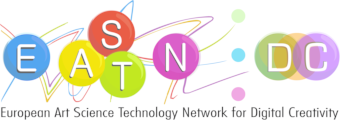The rectangular grid, in the meaning of mechanical arrangement structure, has been associated with the human culture since the Neolithic revolution. Computers, as contemporary technical-cultural tools, make it possible to find many different solutions of arrangements independently from the grid pattern. The idea of common activity patterns, traditional ways of life, or social and cultural rituals has been again updated in the 1960'. An element of randomness came into art and design in the 90' when computer and information technologies played a key role in radical changes in thinking. But grid pattern layout tradition, the invention of printed text, was followed in the digital layout also. Unlike a rectangular grid arrangement, electronic writing has a character of a cross-linked and developing writing technique. The network of interconnected hypertext was compared with the human neural network (Aarseth, 1997; Bolter, 2001). Writing identity was reflected in hypertext, as dynamic, flexible, variable, and even random. According to several authors (Manovich, 2001; Aarseth, 1997; Bootz and Baldwin, 2010 and others), a paradigm of digital mediation is manifested by changes in the approach to the production, storage, media distribution, and reception of literary, conceptual, or other "textual" artworks. Most spectra of these changes were manifested by programmed forms of art and design production. In the position of an e-literature programmed form, Philippe Bootz reflected those changes in his description of a procedural model of communication and the introduction of performative signs as a part of the aesthetic approach.
Under this influence, it is possible to see the grid layout model as a determinative approach in digital layout creation. The information which flows from the source (made by author) to the target (reader’s reading) could be represented, materialized, or embodied by the digital text layout, which will be shaped on/in various interfaces, instead of the plane and rectangular of "screens". Digital text which is manifested by a layout should take place on/ in current and future, digital and hybrid interfaces. This kind of layout could drag the reader into the text work, and closer to its essence.
According to Katherine N. Hayles, the information, which is embodied in the form of a digital text, is manifested by the dialectical complex of pattern and randomness (Hayles, 1999 p. 25). Donna Haraway defines hybrid forms in the context of real "here” and virtual “elsewhere". Another space is a hybrid space of many different forms of coded information. The posthumanist approach of the digital layout problem solution will change the point of view, which is focused on a human, to the wider equal interrelations of technical biological and human intelligent actors.
Conclusion
The flexible shape of complex and experimental digital layout solutions could be manifested on/in many different interfaces. In this work, I brought a hypothetical solution - the model Transient Pattern. The model offers a space in which the creation of a digital layout could take place in different solutions - free of a grid pattern organization. These considerations pave the way for a new approach to the formal grasp of a digital text arrangement in a more comprehensive, unbiased, and experimental way. The new approach subsequently leads to a change in the aesthetic paradigm in the digital typographic design: from creating a digital text layout as a finally programmed form of an object to variable variations in the process of running the program. It includes a dialectical complex pattern (presenting a systematic rational formal approach) and randomness (of actual reading and variability of interfaces) that open access to hybrid forms. The solution enables the flexible organization of a text in digital and post-digital spaces, in current and future conditions of monitoring the possibilities of new techniques of text production and reception, co-created by human and computer intelligent actors. At the same time, it changes our understanding from redesigned forms of grid or template principles to variable designing by computer processes.
Back
“Reflections: Bridges between Technology and Culture, Physical and Virtual”
is supported by:






